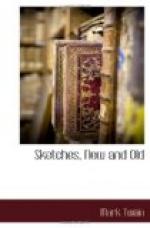“In 1847, in the spring, the river overflowed its banks and covered the whole township. The depth was from two to six feet. More than 900 head of cattle were lost, and many homes destroyed. The Mayor ordered this memorial to be erected to perpetuate the event. God spare us the repetition of it!”
With infinite trouble, Professor Woodlouse succeeded in making a translation of this inscription, which was sent home, and straightway an enormous excitement was created about it. It confirmed, in a remarkable way, certain treasured traditions of the ancients. The translation was slightly marred by one or two untranslatable words, but these did not impair the general clearness of the meaning. It is here presented:
“One thousand eight hundred and forty-seven years ago, the (fires?) descended and consumed the whole city. Only some nine hundred souls were saved, all others destroyed. The (king?) commanded this stone to be set up to . . . (untranslatable) . . . prevent the repetition of it.”
This was the first successful and satisfactory translation that had been made of the mysterious character let behind him by extinct man, and it gave Professor Woodlouse such reputation that at once every seat of learning in his native land conferred a degree of the most illustrious grade upon him, and it was believed that if he had been a soldier and had turned his splendid talents to the extermination of a remote tribe of reptiles, the king would have ennobled him and made him rich. And this, too, was the origin of that school of scientists called Manologists, whose specialty is the deciphering of the ancient records of the extinct bird termed Man. [For it is now decided that Man was a bird and not a reptile.] But Professor Woodlouse began and remained chief of these, for it was granted that no translations were ever so free from error as his. Others made mistakes he seemed incapable of it. Many a memorial of the lost race was afterward found, but none ever attained to the renown and veneration achieved by the “Mayoritish Stone” it being so called from the word “Mayor” in it, which, being translated “King,” “Mayoritish Stone” was but another way of saying “King Stone.”
Another time the expedition made a great “find.” It was a vast round flattish mass, ten frog-spans in diameter and five or six high. Professor Snail put on his spectacles and examined it all around, and then climbed up and inspected the top. He said:
“The result of my perlustration and perscontation of this isoperimetrical protuberance is a belief at it is one of those rare and wonderful creation left by the Mound Builders. The fact that this one is lamellibranchiate in its formation, simply adds to its interest as being possibly of a different kind from any we read of in the records of science, but yet in no manner marring its authenticity. Let the megalophonous grasshopper sound a blast and summon hither the perfunctory and circumforaneous Tumble-Bug, to the end that excavations may be made and learning gather new treasures.”




